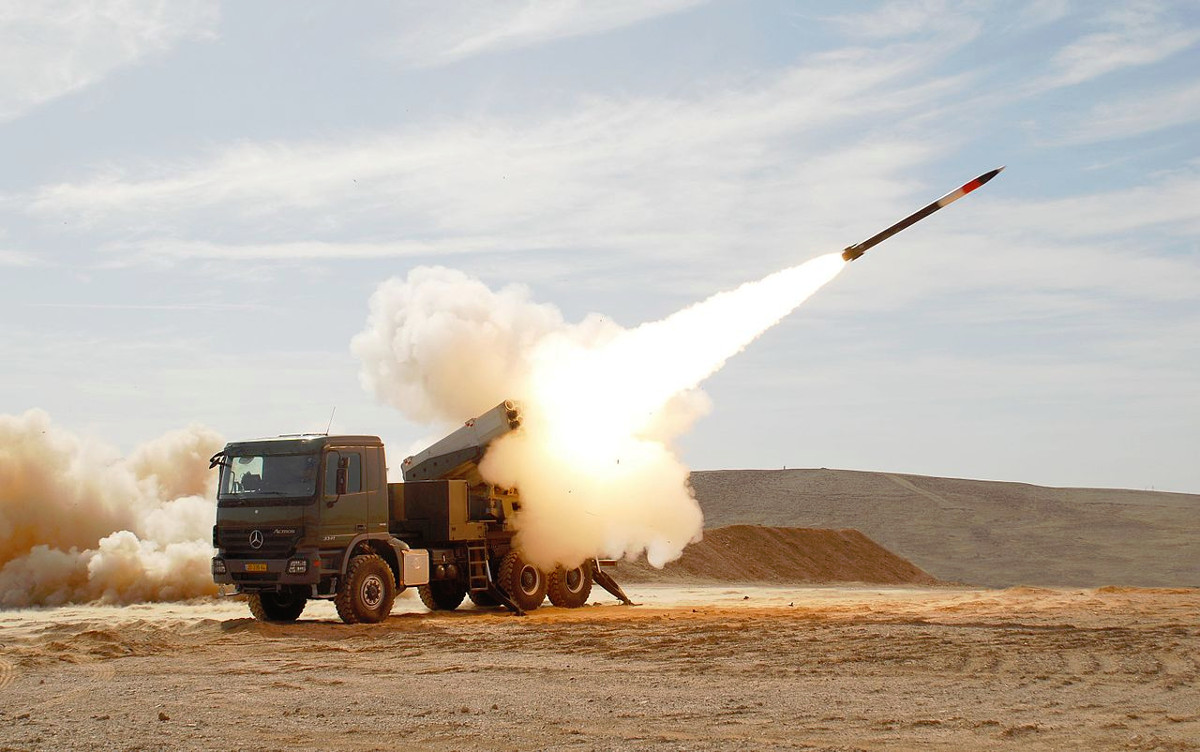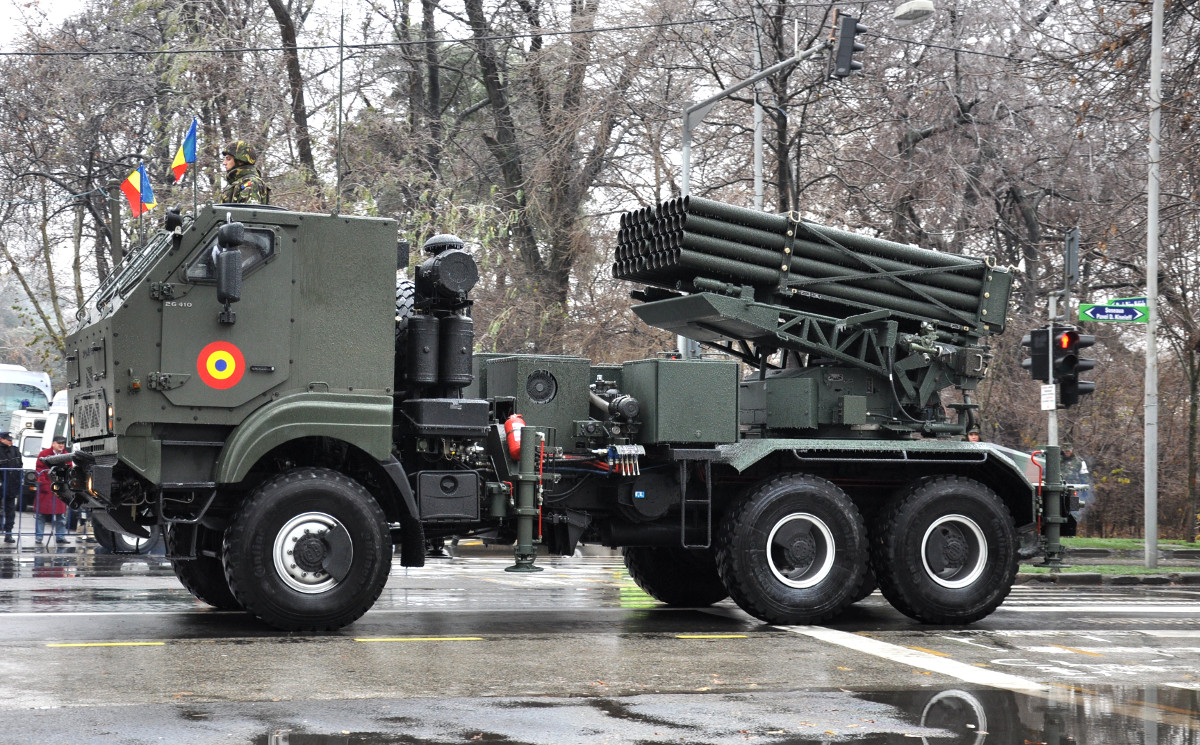Israeli defense contractor Rafael is working on an add-on upgrade package, known as the Electro-Optical Precision Integration Kit, or EPIK, that could turn any Soviet-standard 122mm Grad artillery rocket into a precision-guided round capable of hitting stationary or moving targets. The company says that it hopes to further develop the system to work with other unguided surface-to-surface weapons, potentially offering a relatively simple and low-cost way for military forces around the world to significantly expand their longer-range precision fire support capabilities.
Jane’s 360 was first to report on the EPIK development earlier in May 2018. Rafael said it had waited until it reached the technology demonstration phase of the program, which came after the test firing of multiple experimental rockets equipped with the guidance system, to disclose the project. The Israeli government-owned company did not say if it had any prospective customers lined up already or when it expected the first production rounds would be available.
“A considerable number of ground forces have unguided surface-to-surface rockets in their inventories – these have a high circular error probable – meaning they don’t hit the target precisely, they hit around it,” Gal Papier, the head of Marketing and Business Development for Rafael Advanced Defense Systems’ Precision Tactical Weapons Systems division, told Jane’s. “Consequently, over the past two years we’ve leveraged that technology to inform development of the EPIK concept to address growing demands from ground forces for a solution that can engage autonomously, in multiple areas and hit multiple targets, with precision, simultaneously.”
EPIK consists of a multi-mode sensor package and moving control surfaces that attach to the front of the rocket. It has infrared and laser sensors and an inertial navigation system (INS) with embedded GPS, which allows the round to engage a wide variety of targets, including moving vehicles.

Rafael did not specifically say whether or not the complete weapon system had a man-in-the-loop targeting capability, but it is a possibility. The guidance system is a derivative of the systems the company developed for SPICE – standing for Smart, Precise Impact, Cost-Effective – a family of precision-guided aerial bombs, which has this capability.
Man-in-the-loop type systems are also increasingly a hallmark of Israeli precision-guided munitions in general. What this means is that an actual person can maneuver the round in its terminal phase of flight, helping to improve accuracy to an extreme degree. This also provides opportunities to engage enemy forces that are trying to relocate as the rocket is hurtling toward the target area or shift the point of impact to avoid innocent civilians or other collateral damage that might only become apparent at the last moment.
However, the need for a two-way data link could easily limit how far away an EPIK-equipped rocket might be able to make use of this capability. A 122mm round might be moving too fast to effectively make use of it at all, too.

The INS can either help direct the weapon to the general target area or engage specific stationary targets in a fire-and-forget mode. According to Rafael, the guidance package has scene-matching and signal-processing capabilities that could allow a rocket with EPIK to autonomously zero in on specific areas of interest, too.
Especially notable, Papier stressed to Jane’s that the GPS component of the guidance system is a backup only, with the other sensors and INS acting as the primary means of directing the rocket. Combined with the man-in-the-loop capability, this could make EPIK effective even in a GPS-denied environment, which an increasingly realistic possibility on modern battlefields.
It’s not clear whether EPIK requires any modification to the rocket’s warhead or if it will only work with certain types. Papier implied that it required minimum effort to add the kit onto existing rounds and said that simplicity would make it a relatively easy proposition to integrate the system onto almost any other artillery rocket system.
“We’ve now completed risk mitigation of the process of installing the add-on kit on a rocket – primarily with the 122mm Grad surface-to-surface rocket,” he explained. “We can add EPIK to any caliber of unguided surface-to-surface effector [weapon system] that has a motor and warhead.”

Depending on how much it costs to add the guidance kit to each rocket, and what additional equipment needs to go into the launch platform to employ the guided rounds, EPIK could see world-wide appeal just as an option for the 122mm rocket and nothing more. First developed by the Soviet Union in the 1960s and commonly known Grad, or “hail,” this standardized rocket artillery caliber remains immensely popular with different types of rounds with various warheads and range capabilities still in production in more than dozen countries. The rockets have proven to be such a durable weapon system that Israel employs its own variants, while also defending against attacks from terrorists and militants using their own versions of the rockets.


The predominant type of warhead is a high-explosive fragmentation type best suited to engaging troops and light vehicles in the open. There are also various cluster munition types available. Depending on the warhead and motor, the rockets can have ranges anywhere between eight and 25 miles. Serbian firm EDePro claims that its newest G-2000 type has the longest range of any presently available 122mm round at over 30 miles.
There are various launchers in service with various countries mounted on wheeled and tracked chassis, as well as improvised and production man-portable systems. One of the most common configurations is a 40-round launcher on the back of a 6×6 truck, typically referred to by the Russian nomenclature BM-21. By far the most extreme variation on the concept is a semi-trailer-mounted system from the UAE with 240 tubes arranged in four individual arrays of 60 tubes each.
The 122mm round is so popular, though, that EPIK isn’t even the only guided option Israeli firms are developing for the launchers. In 2017, Israel Military Industries (IMI), another state-run enterprise, unveiled the AccuLAR-122, a derivative of the 160mm AccuLAR-160, with LAR standing for “light artillery rocket” in both cases. Unlike Rafael’s guidance system, this round only has GPS-assisted INS guidance.

IMI said it had developed the complete weapon system, mounted on an air-transportable 6×6 tactical truck, in response to demands from the country’s special operations forces for highly mobile and accurate fire support during operations when they might find themselves separated from traditional artillery and air support. The same logic would apply to conventional forces conducting expeditionary or distributed operations especially in regions, such as the Pacific, where forces might be fighting along a front stretching hundreds of miles that include specific areas that may be physically separated from each other by vast bodies of water or other natural obstacles.
The U.S. Army and Marine Corps have actually already conclusively demonstrated the viability of the basic concept by attaching conventional rocket artillery units with the 227mm High Mobility Artillery Rocket System (HIMARS), which is also truck-mounted, to special operations elements in countries such as Iraq, Syria, and Afghanistan. In these cases, HIMARS offers a much more responsive long-range fire support weapon that is also accurate enough to engage specific individuals and other small targets during limited operations.
EPIK would be an even more flexible option, possibly even using its moving target capabilities to engage small ships, boats, and watercraft in a littoral environment. The ability of the rockets to independently and autonomously find targets would allow a single launcher to engage a swarm of boats, too.
In the hotly disputed South China Sea region, Vietnam has already deployed Israeli-made EXTRA GPS/INS guided artillery rockets to areas under its control in order to challenge fixed Chinese positions on neighboring islands. Combining them with EPIK-equipped 122mm systems could dramatically expand the country’s ability to threaten China’s activities in the region and would serve as a model that other countries in the region, or in more constrained environments
elsewhere in the world, might be inclined to follow.

And as Papier noted, operators of 122mm rocket launchers have stockpiles of unguided rounds already and it would likely be more cost-effective to convert that some or all of it than to buy entirely new ammunition. We’ve already seen how effective blending an add-on guidance system to existing warheads and rocket motors can be with the air-launched 70mm Advanced Precision Kill Weapon System II, or APKWS II, which is in increasingly widespread use in the U.S. military and elsewhere.
As such, EPIK could easily be even more of a force multiplier for existing launchers than something like the AccuLAR-122, both during special operations missions or conventional activities. With both EPIK-equipped and regular unguided rounds on hand, units could quickly switch ammunition types to launch saturation attacks against massed conventional forces, as well.
In that vein, Israel has actually adopted the AccuLAR-122, but as an option for its M270 Multiple Launch Rocket Systems (MLRS). These heavy tracked launchers typically fire the same 227mm rounds as the HIMARS, or a single quasi-ballistic missile, but can fire the smaller rockets – in guided or unguided form – using a special, modular pod.

This could expand the number of countries who might be interested in a 122mm guided rocket, even if only as a low-cost alternative to 227mm rounds in either the MLRS or HIMARS systems. HIMARS, in particular, has gained significant notoriety from its combat performance in Iraq and Syria with NATO members Poland and Romania now looking to be among the newest international operators.
Both of those countries are former Warsaw Pact members and longtime users of 122mm weapons. They likely still have significant stocks of those rockets, which might remain useful rounds for their HIMARS using a combination of an appropriate pod and a guidance kit such as EPIK.

Any of the dozens of existing 122mm rocket launcher operators could be just as interested in EPIK, though. If Rafael can keep the conversions simple and the costs down, they’ll already have a large potential market before even having to consider expanding into other calibers.
Contact the author: jtrevithickpr@gmail.com
